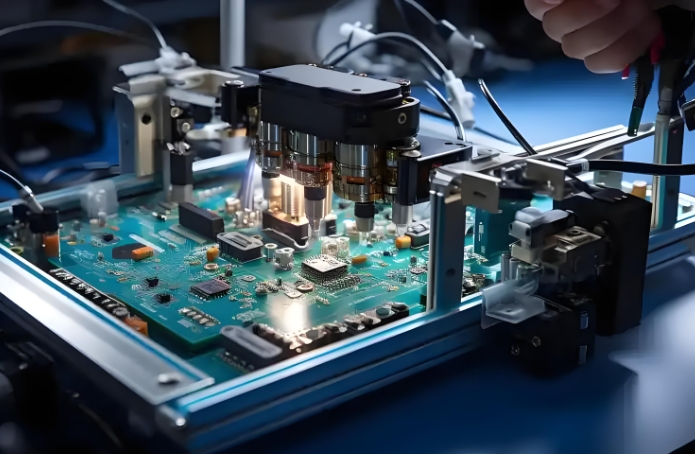Printed circuit board (PCB) substrates play a vital role in modern electronic devices. As the cornerstone of electronic components, PCB substrates not only carry various electronic components, but also ensure the stability and reliability of electrical connections.
Basic Concepts of PCB Substrates PCB substrates refer to boards made of insulating materials (such as epoxy resin, glass fiber, etc.), which are covered with one or more layers of conductive film (usually copper foil) for assembling electronic components and realizing circuit connections. PCB substrates can be divided into single-layer boards, double-layer boards and multi-layer boards according to the number of layers. Single-layer boards have only one layer of conductive film, double-layer boards have two layers of conductive film, and multi-layer boards can have three or more layers of conductive film.

PCB Substrates
PCB Substrate Manufacturing Process The production of PCB substrates requires multiple complex and delicate processes, mainly including the following steps:
1. Material selection First, select the appropriate substrate material. The most commonly used substrate material is FR-4, which is made of glass fiber reinforced epoxy resin and has excellent electrical insulation properties and mechanical strength. In addition, other high-frequency, high-temperature or flexible materials can also be selected according to specific application requirements.
2. Graphic transfer Next, the circuit pattern is transferred to the substrate by chemical or mechanical means. Common methods include photolithography and screen printing. Photolithography uses photosensitive materials and ultraviolet exposure to accurately copy the circuit pattern to the substrate; screen printing is more suitable for simple, large-scale circuit pattern production.
3. Etching process The excess part of the copper foil layer is removed by chemical corrosion or laser etching, leaving only the required circuit pattern. Chemical corrosion is a common method that can obtain fine circuit patterns by controlling the concentration and corrosion time of the etching solution. Laser etching relies on the precise positioning and efficient removal of high-energy laser beams, and is suitable for the production of high-precision and high-density circuits.
4. Lamination and drilling Multi-layer PCB substrates require multiple layers of copper-clad boards to be stacked together, and heat pressing and high pressure are used to achieve close bonding between layers. This step is called lamination. After lamination, holes are drilled on the PCB according to design requirements. These holes are not only used for the insertion of electronic components, but also for conductive connections between circuits on each layer.
5. Surface treatment and testing Finally, the PCB substrate is surface treated to improve its corrosion resistance and weldability. Common surface treatment methods include tin plating, gold plating, and nickel-gold immersion. After completing all processes, the PCB substrate needs to be strictly tested for electrical and mechanical properties to ensure that it meets the design and quality requirements.
Application fields of PCB substrates With the continuous development of electronic technology, PCB substrates are increasingly used in various fields, mainly including the following aspects:
1. Consumer electronics PCB substrates are widely used in consumer electronic products such as mobile phones, computers, and tablets. These products put forward high-density, high-speed, and high-reliability requirements for PCB substrates to meet the needs of complex circuits and high-speed signal transmission.
2. Automotive electronics In the fields of smart cars and autonomous driving, PCB substrates are used for control systems, sensors, entertainment systems, etc. Automotive electronics puts forward higher standards for the high temperature resistance, impact resistance, moisture resistance and other properties of PCB substrates.
3. Communication equipment In 5G base stations, communication terminals and other equipment, PCB substrates are used for antennas, power modules and signal processing units. Communication equipment requires PCB substrates to have good high-frequency performance and electromagnetic compatibility.
4. Medical electronic PCB substrates are used in medical equipment for vital sign monitoring, image processing and data transmission. Medical electronic products have extremely high requirements for the safety and reliability of PCB substrates.
Future development trend of PCB substrates With the advancement of science and technology and changes in market demand, the development of PCB substrates has also shown some new trends and directions:
1. High frequency and high speed With the development of 5G communication and high-speed computing, PCB substrates need to have better high-frequency transmission performance and high-speed signal processing capabilities. This requires further improvement of materials and processes to meet the needs of high speed and low latency.
2. Green environmental protection The enhancement of environmental protection awareness has promoted the research and development and application of green environmental protection PCB substrates. For example, the use of halogen-free materials and environmentally friendly processes can reduce the emission of harmful substances and the impact on the environment during the production process.
3. The continuous miniaturization and integration of miniaturized electronic products require PCB substrates to have smaller sizes and higher integration. This requires more sophisticated manufacturing processes and higher-performance materials to support miniaturization and high-density wiring.
4. Intelligent manufacturing The application of intelligent manufacturing technology will significantly improve the production efficiency and quality control level of PCB substrates. The introduction of technologies such as automated production lines, machine vision inspection and big data analysis will help manufacturers achieve efficient and accurate PCB substrate production.